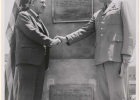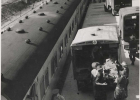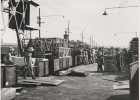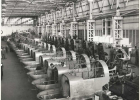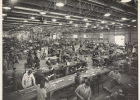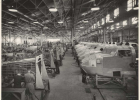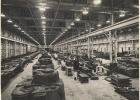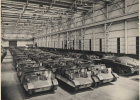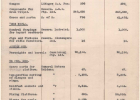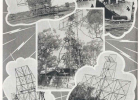NSW Government Railways
Transport
During World War II the NSW Government Railways carried out two main roles: moving and arming. Their first, and more traditional, role was the transport of military personnel and supplies, raw materials and equipment for war industries, along with the usual goods and passengers. With road transport limited by the need to import oil and sea transport under attack from enemy submarines, the railways were vital to the war effort. In the peak year of 1943-44 the NSW Government Railways moved over 13,686 million gross ton-mileage and 250 million passengers (not including military personnel).
Manufacture
The NSW Government Railways’ other role was the manufacture and/or assembly of a wide variety of defence needs, using skills and tools that usually built and repaired railway engines and rolling stock. The Railways made machine tools, jigs and gauges; shells; radar antennas; tanks; aircraft parts; gun barrels, shields and brackets; military and hospital tents, collapsible canvas water tanks, haversacks and kit bags, gun covers and 2,550 miles (4023.4 kilometres) of rope. In addition to this, they also maintained their engines and running stock, expected to perform well beyond their peacetime limits, and built and modified wagons to transport military supplies.
Munitions and defence equipment were manufactured by commercial firms and state government departments, including the Randwick depot of the NSW Government Tramways. State government and private engineering firms, co-ordinated by the Commonwealth government, worked together to meet Australia’s defence needs and create ‘mass production, on a nation-wide scale, of materials and articles of a higher degree of complexity and accuracy than had before been attempted in Australia’ (Mellor, p.1).
List of images used in this Gallery
1. Moving military vehicles, Ryde – Digital id 17420_a014_a014001298
2. Transporting tanks, Homebush – Digital ID 17420_a014_a014001307
3. Feeding the troops – NRS 20017 [A92-4/11] Railways at War pp24-5
4. Moving a million Americans – NRS 20017 [A92-4/8].
The plaque reads ‘Commemorating the first landing of the U.S. Armed Forces at the Port of Sydney on 28th March 1942. During the Second World War 1,000,000 personnel and 5,000,000 tons of materials followed, and were transported through the Port of Sydney and by the N.S.W. Department of Railways.’
5. Carrying the wounded – Digital ID 17420_a014_a014001302
6. Caring for the wounded – Digital ID 17420_a014_a014001306
7. Crated aeroplane petrol tanks being transhipped by manual labour – Digital ID 17420_a014_a014001319
8. Building the Beaufort Torpedo Bomber – Digital ID 17420_a014_a014001254
The Bristol Beaufort Bomber included parts manufactured by 600 firms separated by thousands of kilometres, over three Australian states. The parts were assembled into larger sections of the plane at the railway workshops at Chullora NSW, Newport Vic, and Islington SA. Each of these workshops specialised in different sections of the plane. These larger parts were then turned into finished planes at the two main assembly workshops of the Department of Aircraft Production at Fishermen’s Bend Vic and Mascot NSW.
The Department of Aircraft Production’s factory at the Chullora Workshops made the front fuselage (including the seats of pilot, observer and navigator) and associated control equipment wiring, the retractable undercarriage, the stern frame, the engine nacelle fairing, and engine bulkhead panels. This image shows the front fuselages being fitted out on 6 April 1942. Eveleigh Workshops constructed wooden, leather or fabric covered parts.
For a full list of firms involved see Beaufort Restoration webpage
9. BE EXACT! – Digital ID 17420_a014_a014001287
10. 13,833 square metres of factory – Digital ID 17420_a014_a014001272
11. Welding a Nacelle Fairing – Digital ID 17420_a014_a014001285
12. Lighting the Tank Annexe – Digital ID 17420_a014_a014001228
13. Machine gun carriers – Digital ID 17420_a014_a014001227
14. Randwick Tramways contribution – NRS 4503 [10/37904] File Defence 4
This is the first of two pages of munitions jobs completed at the Randwick Tramway Workshops by the Department of Road Transport and Tramways. The list was compiled on 15 March 1945. From August 1940 Randwick built Vickers Machine Gun tripods, packaging cases, and spare parts; parts for Bren Guns, 303 rifles, Austen guns, 25 pounder guns, 3 inch anti-aircraft guns, and Lewis guns; parts for machine gun carriers, generators, and charcoal burning kilns; and assembled wheels and axles for Garratt locomotives. The list names the firms the items were made for, including the Ministry of Munitions and General Motors Holden, and thus shows the complex subcontracting that occurred during World War II.
15. Building Radar – NRS 20017 [A92-4/11] Railways at War page 51
Radar systems needed to be strong enough to withstand tropical and wartime conditions, light enough to transport, easily dismantled and reassembled, and powerful enough to do the work. The Railways’ Chief Electrical Engineer’s and Mechanical Engineer’s Branches came up with a light weight antenna that used a rotating gear. It stood on top of a metal and canvas hut that housed the radar equipment. This image from page 51 of Railways at War (Sydney, c.1947) shows some of the aerials they designed and made.
Further information
DP Mellor, The Role of Science and Industry. Australia in the War of 1939-1945, Series 4-Civil-Vol 5, Canberra, 1958 (especially Chapters 14, 18 and 19).
NRS 20017 Item A92-4/11 Railways at War, (Sydney, NSW Government Railways, c.1947)
DAP Beaufort (Mk.VII) Bomber A9-141 – VH-KTW
Research by
Jennifer Sloggett, an Archivist with State Records NSW



